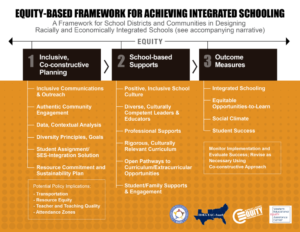Reader Interactions
Resource Library

Equity-based Framework for Achieving Integrated Schooling
The Equity-based Framework for Achieving Integrated Schooling is designed to assist school districts and communities in designing racially and economically integrated schools. It provides a structure for identifying areas of need or support to ensure all students acquire the incredible societal and academic benefits of integrated schooling. For the past two decades, efforts to merely desegregate schools have largely failed. Communities across the United States continue to re-segregate across racial, ethnic and class lines. Today, even many desegregated schools fail to provide an integrated schooling experience in the classrooms and in other programs and activities. As research continues to show promising social, emotional and academic benefits for all children, the demand for truly integrated schools is growing. Consequently, more schools and communities expect whole-school integration not only to reap the educational benefits but also to counter the social harms and divisiveness created by segregated school experiences. The four federally-funded equity assistance centers (EACs) jointly created the Equity-based Framework for Achieving Integrated Schooling to ensure that local communities can get a good visual presentation for better understanding the foundational elements and critical supports for achieving integration throughout the campus experience. Based on research and asset-based practices, the framework identifies three foundational components and underlying support strategies for each: (1) Inclusive, Co-constructive Planning; (2) School-based Supports; and (3) Outcome Measures. A narrative is forthcoming that will help schools apply the framework from a strong equity perspective. For more information, contact your regional equity assistance center.
View Resource